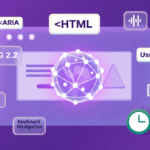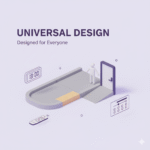|
Getting your Trinity Audio player ready... |

The WCAG Accessibility Guidelines can feel like a maze of numbers, levels, and jargon that only a few people pretend to understand. Most explainers sound like legal manuals written for robots, not people. This post breaks down the Web Content Accessibility Guidelines in plain English so you can actually use them.
If you manage a website, run an online store, or work with a dev team that throws around phrases like AA compliance or success criteria, this is your crash course. You’ll learn what WCAG really is, why it keeps showing up in accessibility conversations, and how it shapes the usability and success of every site that cares about its users.
The Four Principles (POUR)
The WCAG Accessibility Guidelines are built on four simple pillars that decide whether your site is actually usable for everyone:
- Perceivable – Users must be able to see or hear your content.
- Operable – All users can navigate and interact with it, even without a mouse.
- Understandable – The interface and content make sense.
- Robust – Works with today’s and tomorrow’s assistive technologies.
If your product images don’t have text alternatives or your checkout flow breaks with a keyboard, you’ve already failed “Perceivable” and “Operable.”
Read more: Understanding the four principles of accessibility.
The 13 Guidelines
Now that we’ve laid the groundwork with the principles, it’s time to look at the 13 guidelines that serve as your goals for making content accessible.
- Text Alternatives
- Time-based Media
- Adaptable
- Distinguishable
- Keyboard Accessible
- Enough Time
- Seizures and Physical Reactions
- Navigable
- Input Modalities
- Readable
- Predictable
- Input Assistance
- Compatible
Each of these guidelines helps you meet diverse accessibility needs, creating a more inclusive web experience. Dive Deep into the Guidelines!
Success Criteria: The Testable Requirements
Success Criteria are the measurable checkpoints that prove whether your content meets the WCAG guidelines. Think of them as the pass-or-fail tests behind every accessibility goal.
- Level A: covers the absolute minimum. Your site technically works, but users with disabilities will still struggle.
- Level AA: is the practical standard most organizations should aim for. It ensures your site is usable and compliant with most accessibility laws like the ADA, AODA, and EN 301 549.
- Level AAA: goes beyond compliance into excellence. It’s rare outside government or education sites because it demands near-perfect accessibility in every scenario.
Understanding which level you’re targeting helps you plan smarter and fix what actually matters instead of chasing theoretical perfection.
Techniques (The How-To)
Techniques are the practical fixes, how to actually meet those checkpoints. They translate WCAG from theory into code, content, and design decisions you can act on. Think of them as your accessibility recipe book.
- Sufficient Techniques are the officially recognized methods that guarantee compliance.
- Advisory Techniques go beyond the minimum and improve usability for everyone.
- Common Failures show what not to do—like using color alone for error states or skipping focus indicators.
Each technique bridges the gap between compliance and real-world inclusion. Mastering them means fewer accessibility bugs, smoother user flows, and a website that just works for everyone.
WCAG Accessibility Guidelines Matters for Business
WCAG isn’t just a rulebook, it’s a reflection of real user barriers. Each update pushes the web closer to experiences that actually work for more people.
When you fix accessibility gaps, you’re not just meeting guidelines, you’re removing daily frustrations for real customers.
Curious how these principles look in action? Explore my case studies or request a quick audit to see how small accessibility shifts transform usability.

